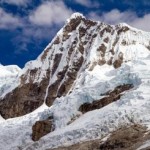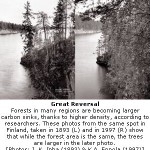 Extreme weather such as hurricanes, torrential downpours and droughts will become more frequent in pace with global warming. Consequently, this increases the risk for species extinction, especially in biologically diverse ecosystems such as coral reefs and tropical rainforests.
Extreme weather such as hurricanes, torrential downpours and droughts will become more frequent in pace with global warming. Consequently, this increases the risk for species extinction, especially in biologically diverse ecosystems such as coral reefs and tropical rainforests.
Human impact means that flora and fauna become extinct at a rate 100-1000 times higher than normal. Climate change has been deemed as one of the main causes of species depletion.
A research team in theoretical biology at Linköping University has, with the help of mathematical modelling and simulation, studied how the dynamics of different types of ecosystems may be affected by significant environment fluctuations.
Linda Kaneryd, doctoral student and lead author of a study recently published in the journal, ‘Ecology and Evolution’, says the results were surprising. Kaneryd explains, “Several previous studies of food web structures have suggested that species-rich ecosystems are often more robust than species-poor ecosystems. However, at the onset of increased environmental fluctuations, such as extreme weather, we see that extreme species-rich ecosystems are the most vulnerable and this entails a greater risk for a so-called cascading extinction.”
In a rainforest or on coral reef, there are a wide variety of species of primary producers such as green plants and algae. Since they are competitors, relatively few individuals of the same species exist, subjecting them to a greater risk of extinction should external conditions change. This could result in a depletion of food sources for a species of herbivores that, in turn, affects a predator at the top of the food chain. Biologists call this transformation a cascading extinction.
The opposite would apply to an ecosystem whereby few species exist in large numbers and animal species are adaptable generalists.
The researchers create their model food webs from their experiences with real ecosystems; what eats what, the composition of the species’ life cycles, and how they interact with others. In this study, external conditions are represented as an increasing and unpredictable variation.
“The model we worked with is quite typical. The next step is to introduce actual, detailed climatic data,” informs Bo Ebenman, Professor of Theoretical Biology, who supervised Linda Kaneryds thesis.
A simple model of a food web with three so-called trophic levels: six plant species (green), four herbivores (yellow) and two top predators (red). When the system is subjected to increased external pressures that simulated extreme weather events, plants 1, 2 and 5 disappeared which reduces the herbivores’ food supply. No. 8 dies out because it was totally dependent on number 2.

Details of the Study:
Source: Linköping University.














